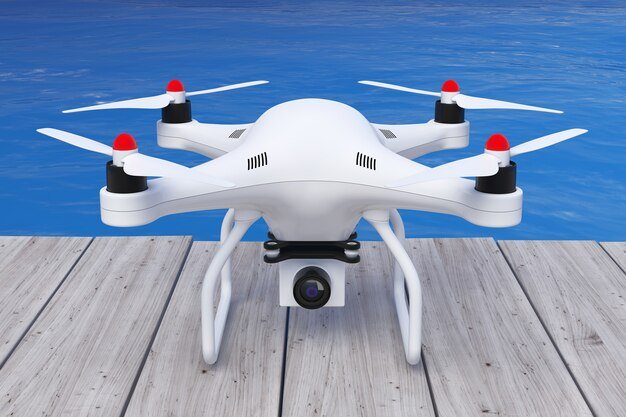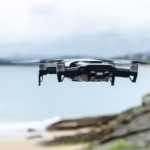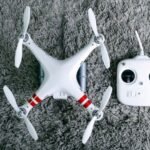Drone camera companies have revolutionized the world of aerial photography and videography, providing exceptional tools for capturing stunning visuals from new perspectives. With advancements in technology, these companies have created drones that offer top-notch camera quality, stability, and intelligent flight features. Whether for professional filmmakers, content creators, or hobbyists, the options available today are more versatile and user-friendly than ever before. In this article, we will highlight the 10 best drone camera companies, known for their cutting-edge innovation and industry-leading products that continue to shape the future of drone technology.
List of 10 Best Drone Camera Companies:
1.DJI – Industry Leader in Smart Drone Camera Tech
DJI is a leading drone manufacturer renowned for its innovative designs and advanced technology. Their drones cater to both professionals and hobbyists, offering a range of models with varying capabilities.
Notable Models:
A. DJI Mavic 3 Pro
Specifications:
- Camera: Triple-camera system with a wide-angle Four Thirds sensor.
- Video Resolution: Up to 5.1K at 30fps or 4K at 120fps.
- Flight Time: Approximately 35 minutes.
- Obstacle Detection: All-around sensors.
Pros:
- High-quality Hasselblad camera.
- Comprehensive obstacle avoidance.
- Long flight time.
- Robust build quality.
- Advanced flight modes.
- Stable GPS.
- User-friendly app.
- Compact and foldable design.
- Excellent low-light performance.
Cons:
- High price point.
- Base model has limited internal storage.
- Falls short of the advertised 43-minute flight time.
- Only the Cine model supports ProRes.
- Requires FAA registration due to weight.
- Complex for beginners.
- Limited availability of spare parts.
- Firmware updates can be frequent.
- No built-in screen on the standard controller.
B. DJI Mini 3
Specifications:
- Camera: 12MP sensor.
- Video Resolution: 4K at 30fps.
- Flight Time: Up to 38 minutes.
- Weight: 249 grams.
Pros:
- Lightweight and portable.
- Good video quality.
- Long battery life.
- No FAA registration required.
- User-friendly interface.
- Stable flight performance.
- Affordable price.
- GPS and Return to Home features.
- Vertical video support.
Cons:
- No obstacle detection.
- Limited to one color profile.
- No support for Hyperlapse or ActiveTrack.
- Limited manual camera controls.
- No 4K at 60fps.
- Plastic build feels less premium.
- Limited range compared to higher-end models.
- No obstacle avoidance sensors.
- Basic controller without a screen.
How to Use:
- Setup: Unfold the drone and attach the propellers.
- Controller: Connect your smartphone to the controller.
- App: Launch the DJI Fly app.
- Calibration: Calibrate the compass and IMU if prompted.
- Flight: Choose a clear area, check GPS signal, and take off.
2. Autel Robotics – High-Tech Innovation in Drone Imaging
Autel Robotics is known for producing high-quality drones with impressive camera capabilities, offering a solid alternative to other leading brands.
Notable Model:
Autel EVO Lite+
Specifications:
- 6K and 8K resolution cameras (EVO II Pro)
- Adjustable aperture (f/2.8–f/11)
- 1-inch CMOS sensor
- 360° obstacle avoidance
- 40-minute flight time
- AI-powered subject tracking
- No geo-fencing restrictions
- Foldable design for portability
- 9KM HD video transmission
Pros:
- Excellent low-light performance
- Long flight time
- Adjustable aperture
- Robust build quality
- No forced no-fly zones
- High-quality camera
- User-friendly interface
- Good customer support
- Multiple color options
Cons:
- Heavier than some competitors
- Limited accessory availability
- No side obstacle sensors
- Higher price point
- Limited third-party app support
- Firmware updates can be infrequent
- No omnidirectional obstacle avoidance
- Limited flight modes compared to competitors
- App interface could be more intuitive
How to Use:
- Setup: Unfold the drone and attach propellers.
- Controller: Power on the controller and connect to the Autel Sky app.
- Calibration: Calibrate the compass and IMU as prompted.
- Flight: Ensure GPS lock, choose an open area, and initiate takeoff.
3. Parrot – Compact Drone Camera Tech with Professional Touch
Parrot is a French drone manufacturer known for its user-friendly designs and innovative features, catering to both consumers and professionals.
Notable Model:
A. Parrot Anafi
Specifications:
- 4K HDR camera with 180° tilt gimbal
- 3-axis hybrid stabilization
- Up to 25 minutes flight time
- Weighs under 320g (Anafi series)
- USB-C charging
- AI-based object tracking
- Dual-band Wi-Fi transmission
- Compatible with Pix4D for 3D mapping
- Geofence and return-to-home safety
Pros:
- Compact and lightweight design
- 180-degree tilt gimbal
- Excellent image quality
- Quiet operation
- USB-C charging
- No geofencing restrictions
- Affordable price
- Easy to fly
- Good range
Cons:
- No obstacle avoidance sensors
- Limited flight time
- No 60fps in 4K
- Limited manual camera controls
- No follow-me mode without subscription
- Fragile build
- Limited customer support
- No internal storage
- App can be unstable
How to Use:
- Setup: Unfold the drone and install the battery.
- Controller: Connect your smartphone to the controller.
- App: Launch the FreeFlight 6 app.
- Calibration: Calibrate the drone as instructed.
- Flight: Choose a safe area, check GPS signal, and take off.
5. Skydio – AI-Powered Autonomous Drone Camera Brand
Skydio is an American drone manufacturer specializing in autonomous flight technology, making their drones adept at obstacle avoidance and tracking.
Notable Model:
Skydio 2+
Specifications:
- 4K60 HDR camera
- Nvidia Tegra-based onboard AI
- 6-sided 360° obstacle avoidance
- Follow and track modes using deep learning
- Flight time up to 27 minutes
- Automated cinematic shots
- GPS-free indoor navigation
- Foldable, rugged design
- Syncs with Beacon controller for extended range
Pros:
- Exceptional obstacle avoidance
- Autonomous flight capabilities
- High-quality video
- Robust build
- User-friendly app
- Reliable GPS
- Impressive tracking features
- AI-driven flight paths
- Good battery life
Cons:
- Limited range compared to competitors
- No manual flying precision like DJI
- No removable camera
- Pricey for casual users
- Not as many accessories available
- Learning curve for first-time users
- Requires a subscription for full features
- Limited customer support
- App could be improved
How to Use:
- Setup: Charge the battery and attach propellers.
- Controller: Connect the controller to your phone.
- App: Open the Skydio app for setup.
- Calibration: Calibrate if prompted.
- Flight: Select an open area, ensure GPS lock, and take off.
6. Holy Stone – Affordable Entry-Level Camera Drone Company
Holy Stone is one of the most accessible drone camera companies for beginners. They are offering stable performance and decent camera quality at affordable prices.
Notable Model:
Holy Stone HS720E
Specifications:
- 1080p to 4K HD camera options
- Optical flow positioning
- GPS-assisted flight
- Up to 46 minutes flight time (with dual batteries)
- FPV live video transmission
- Follow Me and Tap Fly modes
- Foldable compact models
- 3D flips and gesture control
- Emergency stop and altitude hold
Pros:
- Affordable price
- Decent video quality
- Stable GPS positioning
- Foldable design
- Good beginner-friendly controls
- Return to home function
- Multiple flight modes
- Durable construction
- Battery included
Cons:
- No obstacle avoidance
- Limited range
- Average low-light performance
- No advanced camera features
- Fixed aperture
- App connectivity issues
- Shorter battery life than premium models
- No professional-grade footage
- Slow recharge time
How to Use:
- Setup: Attach battery and calibrate sensors.
- Controller: Pair with the included remote.
- App: Use the Holy Stone app for additional controls.
- Flight: Fly in an open area with minimal wind.
7. Yuneec – Reliable Drone Cameras for Commercial and Aerial Use
Yuneec is among those companies with drone cameras made for both hobbyists and commercial users, thanks to its powerful hexacopter options and thermal imaging features.
Notable Model:
Yuneec Typhoon H Plus
Specifications:
- 4K UHD camera with 3-axis gimbal (Typhoon H series)
- Intel RealSense obstacle avoidance
- 360° camera rotation
- Up to 28 minutes of flight time
- Retractable landing gear
- ST16 ground station with 7″ screen
- Live 720p FPV
- Multiple autonomous flight modes
- Supports thermal and zoom modules
Pros:
- Professional-grade camera
- High-end obstacle avoidance
- Stable 6-rotor flight system
- Retractable landing gear
- Good wind resistance
- Reliable GPS
- Customizable controls
- No geofencing restrictions
- Large display on controller
Cons:
- Expensive
- Bulky and heavy
- Fewer accessories compared to DJI
- Limited third-party app compatibility
- Slower speed than competitors
- Battery takes long to charge
- Harder to find replacement parts
- Not ideal for beginners
- Some firmware bugs reported
How to Use:
- Setup: Unfold the drone and attach camera module.
- Controller: Use the ST16S remote control.
- App: Built-in software with Android OS.
- Flight: Select flight mode and take off.
8. Potensic – Budget-Friendly Camera Drones for Learners
Potensic has carved a niche among affordable drone camera companies by delivering easy-to-use drones that don’t compromise on quality.
Potensic Dreamer 4K
Specifications:
- 2K to 4K adjustable cameras
- WiFi FPV transmission
- One-key takeoff/landing
- Up to 20-30 mins flight time
- GPS + altitude hold
- Dual battery options
- Foldable travel designs
- Waypoint, orbit, and follow modes
- 5G transmission in advanced models
Pros:
- Affordable pricing
- Good camera quality for the price
- Stable GPS hold
- Long battery life
- Easy-to-use controller
- Lightweight and compact
- Return-to-home function
- Multiple flight modes
- Decent wind resistance
Cons:
- No obstacle avoidance
- Limited camera stabilization
- Not for professional use
- Lower range than high-end models
- No geofencing features
- App connectivity issues
- Charging takes time
- Limited third-party accessories
- Basic flight controls
How to Use:
- Setup: Attach propellers and insert battery.
- Controller: Connect smartphone and power on.
- App: Use the Potensic app for additional controls.
- Flight: Fly in an open area, monitor battery life.
9. Ruko – Smooth Flying Drones with Impressive Cameras
Ruko may be a newer name in the market, but it’s quickly being recognized among top drone-camera-focused companies due to its stable controls and 4K imaging.
Ruko F11 Pro
Specifications:
- 4K UHD camera with wide-angle lens
- GPS-assisted intelligent flight
- Dual batteries (up to 60 mins combined)
- Auto Return-to-Home
- Optical Flow + Altitude hold
- Brushless motors for stability
- 5GHz FPV real-time transmission
- Follow Me, Tap Fly, and Orbit mode
- Easy-to-use app interface
Pros:
- Budget-friendly
- Decent camera quality
- Long battery life
- Foldable and portable design
- GPS-assisted flight
- Return-to-home feature
- Stable hovering ability
- Good for beginners
- Brushless motors for durability
Cons:
- No obstacle avoidance
- Limited video resolution
- Shorter range compared to premium models
- Lacks advanced flight modes
- Can struggle in strong winds
- No professional-grade camera stabilization
- Slower charging time
- No removable camera
- App connectivity issues reported
How to Use:
- Setup: Charge the battery and install the propellers.
- Controller: Pair the controller with the drone.
- App: Use the Ruko app for enhanced features.
- Flight: Select an open area and start flying.
10. EXO Drones – Powerful US-Based Drone Camera Brand
As a fast-growing US-based brand, EXO is quickly rising on the list of drone camera companies that balance high-end features with mid-range pricing.
A. EXO Blackhawk 2
Specifications:
- 4K UHD stabilized camera
- 3-axis mechanical gimbal
- Flight time up to 35 minutes
- Obstacle avoidance sensors
- Real-time video feed via app
- Long-range signal (up to 5 miles)
- Intelligent return-home feature
- Custom flight paths
- Foldable, lightweight build
Pros:
- High-resolution camera
- Good low-light performance
- Long flight time
- Foldable and lightweight design
- GPS-assisted flight stability
- Obstacle avoidance system
- Smart flight modes
- Strong wind resistance
- Affordable alternative to premium drones
Cons:
- Limited obstacle avoidance capabilities
- Smaller brand with less support
- Limited availability in some regions
- Video transmission range is shorter than competitors
- App requires improvements
- No professional-grade gimbal stabilization
- Firmware updates can be slow
- Replacement parts can be hard to find
- Less known brand, fewer accessories available
How to Use:
- Setup: Charge the battery and attach propellers.
- Controller: Pair with the remote control.
- App: Use the EXO Drones app for advanced controls.
- Flight: Choose a flight mode and start flying.
Conclusion:
In conclusion, the top 10 camera drone companies continue to push the boundaries of aerial photography and videography, offering innovative designs, cutting-edge technology, and user-friendly features. Industry leaders like DJI dominate with their high-performance drones, while companies like Autel Robotics, Parrot, and Skydio provide competitive alternatives catering to various needs, from professional filmmaking to autonomous flight capabilities.
If you’re interested in exploring the features each brand offers, make sure to check out the Different Types Of drone Cameras to find the perfect fit for your flying needs.



